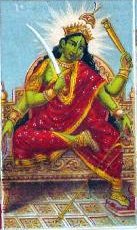Matangi
| Matangi | |
|---|---|
| Goddess of the spoken word and supernatural powers | |
 |
|
| Devanagari | मातङ्गी |
| Sanskrit transliteration | Mātaṅgī |
| Affiliation | Devi, Mahavidyas |
| Abode | On the periphery of traditional society and in speech |
| Planet | Surya |
| Mantra | Aim, Aum Hring Kling Hum Matangaiye Phat Swaha |
| Consort | Shiva |
Matangi is one of the Mahavidyas, ten Tantric goddesses and a ferocious aspect of Devi, the Hindu Divine Mother. She is considered to be the Tantric form of Sarasvati, the goddess of music and learning. Like Sarasvati, Matangi governs speech, music, knowledge and the arts. Her worship is prescribed to acquire supernatural powers, especially gaining control over enemies, attracting people to oneself, acquiring mastery over the arts and gaining supreme knowledge.
Matangi is often associated with pollution, inauspiciousness and the periphery of Hindu society, which is embodied in her most popular form, known as Ucchishta-Chandalini or Ucchishta-Matangini. She is described as an outcaste (Chandalini) and offered left-over or partially eaten food (Ucchishta) with unwashed hands or food after eating, both of which are considered to be impure in classical Hinduism.
Matangi is often represented as emerald green in colour. While Ucchishta-Matangini carries a noose, sword, goad, and club, her other well-known form, Raja-Matangi, plays the veena and is often pictured with a parrot.
The Dhyana mantra (a mantra that details the form of the deity on which a devotee should meditate) of the Brhat Tantrasara describes Ucchishta-Matangini, one of the most popular forms of the goddess. Matangi is seated on a corpse and wears red garments, red jewellery and a garland of gunja seeds. The goddess is described as a young, sixteen-year-old maiden with fully developed breasts. She carries a skull and a sword in her two hands, and is offered leftovers.
The Dhyana mantras in the Purashcharyarnava and the Tantrasara describe Matangi as blue in colour. The crescent moon adorns her forehead. She has three eyes and a smiling face. She wears jewellery and is seated on a jewelled throne. In her four arms, she carries a noose, a sword, a goad, and a club. Her waist is slim and her breasts well-developed.
The Dhyana Mantra of Raja-matangi from the Purashcharyarnava describes Matangi as green in colour with the crescent moon upon her forehead. She has long hair, a smiling expression and intoxicated eyes, and wears a garland of kadamba flowers and various ornaments. She perspires a little around the face, which renders her even more beautiful. Below her navel are three horizontal folds of skin and a thin vertical line of fine hair. Seated on an altar and flanked by two parrots, she represents the 64 arts. The Saradatilaka, adds to this description that Raja-Matangi plays the veena, wears conch-shell earrings and flower garlands, and has flower paintings adorning her forehead.
...
Wikipedia
